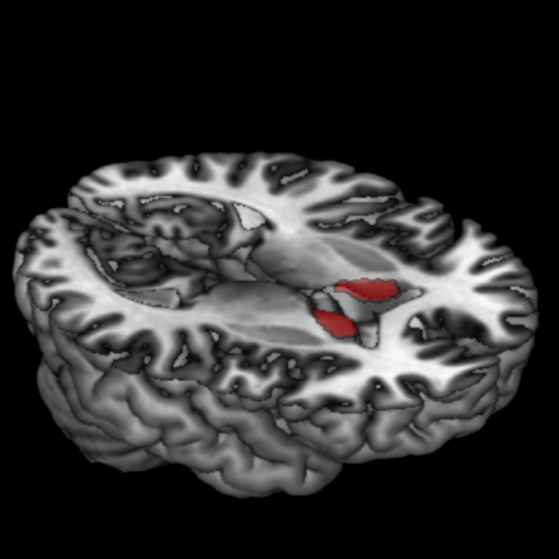Mutations in FTO and Dopamine Receptor Genes Increase Risk of Obesity and Diabetes

Insulin sensitivity in the caudate nucleus depends on mutations in the FTO gene and the dopamine D2 receptor gene DZD
More and more people throughout the world suffer from obesity. Currently about 500 million people are obese, including about 15 million in Germany. The causes of obesity are often an unhealthy diet, too little physical activity and a genetic predisposition. In particular, people with an altered obesity risk gene called FTO (FTO is the abbreviation for “fat mass and obesity-associate) are more often obese.
But how do the gene variants work? Why can they cause people to become overweight? “FTO is strongly expressed in the central nervous system,” said PD Dr. Martin Heni of the Institute for Diabetes Research and Metabolic Diseases (IDM) of Helmholtz Zentrum München at the University of Tübingen.
“Studies on rodents show that altered FTO influences dopamine signaling in the brain and thus leads to higher food intake.” The “reward hormone” dopamine plays an important role in the regulation of appetite. If the information that you have already eaten is not transmitted correctly, then your desire for food increases. One of the causes for this may be an insufficient number of dopamine D2 receptors to which the neurotransmitter binds.
Researchers of the German Center for Diabetes Research have now investigated the effects when both the FTO gene and the gene for the dopamine D2 receptor, ANKK1/Taq1A, are mutated. For this purpose, they examined samples from the Tübingen Family Study (n = 2245) and the Malmo Diet and Cancer Study (n = 2921). They found that about 20 percent of the participants were carriers of both mutations.
“Our studies show that when both genes are mutated, this can have a far-reaching effect on health. If due to the ANKK1 polymorphism there are fewer dopamine D2 receptors, those affected with mutated FTO have a higher percentage of body fat, more abdominal fat and low sensitivity to insulin in the body. In addition, in the caudate nucleus, the brain region that is important for dopamine metabolism, insulin sensitivity was altered,” said Heni, summarizing the results. “From this we conclude that the effects of a mutated FTO gene depend on the number of dopamine D2 receptors,” added his IDM colleague Professor Hubert Preissl. If an affected individual is a carrier of both mutated genes, his or her risk of diabetes and obesity is increased. “Unfortunately, this unfavorable combination of both gene mutations is present in about one-fifth of the population,” said Heni.
The findings suggest that FTO influences dopamine signaling not only in rodents, but also in humans. This interaction not only appears to be important for body weight, but also for the metabolism in the entire body. FTO gene mutations are important risk factors for overweight and diabetes. However, the effects are less critical if there are sufficient dopamine D2 receptors.
Background Information
FTO
The fat mass and obesity-associate FTO gene is not a gene in the classical sense. It consists of 47,000 nucleotides on chromosome 16. There, 87 gene variants have been discovered, which together are detectable in about 44 percent of all Europeans and increase the risk of obesity in this population. Therefore, scientists suspect that one or more control genes are involved, which favor weight gain through their effect on other genes.
Dopamine
Dopamine is an important, predominantly stimulating neurotransmitter. It is commonly known as the “reward hormone” or “happiness hormone”. For example, the neurotransmitter is responsible for making people feel happy after an enjoyable meal. However, if there are fewer dopamine D2 receptors in the brain, people must eat more to attain this feeling of happiness. One cause for a low density of dopamine D2 receptors is the gene variant ANKK1/TaqIA.
Tübingen Family Study
In the Tübingen Family Study, scientists investigate people at increased risk for type 2 diabetes. Many study participants already have a disturbed glucose tolerance or blood glucose levels in the upper normal range.
Contact
PD Dr. med. Martin Heni
Oberarzt
Universitätsklinikum Tübingen
Medizinische Klinik, Abteilung IV (Endokrinologie, Diabetologie, Nephrologie, Angiologie und klinische Chemie)
Otfried-Müller-Str. 10, 72076 Tübingen
E-Mail: Martin.Heni (at) med.uni-tuebingen.de
Media Contact
More Information:
http://www.dzd-ev.de/All latest news from the category: Life Sciences and Chemistry
Articles and reports from the Life Sciences and chemistry area deal with applied and basic research into modern biology, chemistry and human medicine.
Valuable information can be found on a range of life sciences fields including bacteriology, biochemistry, bionics, bioinformatics, biophysics, biotechnology, genetics, geobotany, human biology, marine biology, microbiology, molecular biology, cellular biology, zoology, bioinorganic chemistry, microchemistry and environmental chemistry.
Newest articles

A ‘language’ for ML models to predict nanopore properties
A large number of 2D materials like graphene can have nanopores – small holes formed by missing atoms through which foreign substances can pass. The properties of these nanopores dictate many…

Clinically validated, wearable ultrasound patch
… for continuous blood pressure monitoring. A team of researchers at the University of California San Diego has developed a new and improved wearable ultrasound patch for continuous and noninvasive…

A new puzzle piece for string theory research
Dr. Ksenia Fedosova from the Cluster of Excellence Mathematics Münster, along with an international research team, has proven a conjecture in string theory that physicists had proposed regarding certain equations….



